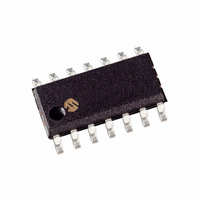HCS473T/SL Microchip Technology, HCS473T/SL Datasheet - Page 23

HCS473T/SL
Manufacturer Part Number
HCS473T/SL
Description
IC KEELOQ 3AXIS TRANSCODR 14SOIC
Manufacturer
Microchip Technology
Series
KEELOQ®r
Type
Code Hopping Encoder and Transponderr
Specifications of HCS473T/SL
Applications
Access Control Systems
Mounting Type
Surface Mount
Package / Case
14-SOIC (3.9mm Width), 14-SOL
Lead Free Status / RoHS Status
Lead free / RoHS Compliant
TABLE 3-4:
3.2.1.8
The initial Field Acknowledge sequence, occurring dur-
ing the wake-up pulse, may be disabled by enabling the
Skip Field Acknowledge configuration option (SKI-
PACK=1). Omitting the ACK slightly minimizes a
HCS473’s average communication current draw, but
conversely will increase average authentication time as
the wake-up pulse must then be the maximum start-up
filter charge time, T
3.2.2
Data to and from the HCS473 is always sent Least Sig-
nificant bit first. The data length and modulation format
vary with the particular command sequence and the
transmission path.
3.2.2.1
Commands from the transponder reader to the
HCS473 as well as the responses from the HCS473
over the low frequency path (LC pins) are Pulse Posi-
tion Modulated (PPM) according to Figure 3-10.
Communication from the transponder reader to a
HCS473 is via the reader amplitude shifting a 125kHz
low frequency (LF) field.
LF responses back to the transponder reader are
achieved by the HCS473 applying a low-resistance
short from the LC pins to LCCOM (configuration option
LCRSP enables LF talkback). This short across the
antenna inputs is detected by the reader as a load on
its 125kHz transmitting antenna.
See Section 5.4 for further details on inductive commu-
nication principles.
2002 Microchip Technology Inc.
RFRSP LCRSP
0
0
1
1
TRANSPONDER COMMUNICATION
Skip Field Acknowledge (SKIPACK)
LC Communication Format
0
1
0
1
HCS473 RESPONSE OPTIONS
SF
No response
Response over the LC pins
Response through the DATA pin
Response through the DATA pin
first and then the LC pins
MAX
.
Description
Preliminary
FIGURE 3-10:
3.2.2.2
The RF responses on the DATA pin vary with the infor-
mation being returned.
• Acknowledge responses are based on the LF
• Data code words responses are based on the
3.2.2.3
The transponder reader initiates each communication
sequence by turning on the low frequency field, then
waits for a HCS473 to Acknowledge the field.
The HCS473 enters Transponder Mode after detecting
a signal on any LC low frequency antenna input pin that
has remained high for at least the start-up filter time
T
Acknowledge sequence indicating that it has detected
the LF field, is in Transponder Mode and is ready to
receive commands (Figure 3-11). The wake-up pulse’s
falling edge must then occur within T
the Field Acknowledge sequence.
The Field Acknowledge sequence may optionally be
disabled by enabling the Skip Field ACK configuration
option, Section 3.2.1.8.
In both cases, the first command bit must begin within
T
HCS473 will return to Low Power mode.
Representation
Representation
SF
CMD
‘0’
‘1’
RF
Encoder mode options, Section 3.1.4.
125kHz
125kHz
, Table 7-5. The device then responds with a Field
Digital
Digital
TE
of the wake-up pulse’s falling edge or the
, using the format determined by the
RF DATA Communication Format
Wake-up Sequence
previous bit
START or
LC PIN PULSE POSITION
MODULATION (PPM)
1LF
2LF
TE
TE
1LF
HCS473
DS40035C-page 21
TE
CMD
1LF
of the end of
TE
TE
.














